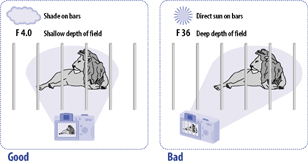Hack 93 Photograph Zoo Animals Without Bars
| < Day Day Up > |
| With a little photographic wizardry, you can take pictures of your favorite animals at the zoo and eliminate the bars that stand between you . Zoos and animal parks present great opportunities for wildlife shots that many of us would be unable to get otherwise . The problem is that we have to contend with those troublesome bars. Or do we? This hack shows how to set your images free; you can get great animal shots and eliminate the bars that cage them. You can get rid of the bars, or minimize their impact on the photo, by taking advantage of the same shallow depth of field you use to blur the background in portrait shots [Hack #27] . However, in this case you want to blur the foreground. You need to open the aperture wide to make the depth of field shallow, with only the subject in focus, not the bars. Figure 8-20 shows the difference that changing the aperture can make. Figure 8-20. Same shot at different aperturesf-4.5 and f-36 The easiest way to shoot with the aperture wide open is to put the camera in AV ( Aperture Value or, as we refer to it, Aperture Priority ) mode so that you set the aperture while the camera picks the best shutter speed to obtain a good exposure. Once you're in AV mode, just set the aperture to as low a number as possible, such as f-2.8, f-3.5, f-4.5, or f-5.6. If your camera doesn't have an AV mode, give Portrait mode a try. This setting usually makes the camera favor a larger aperture. The next thing to think about is your position in relation to the animal and the bars. The ideal situation is for you to be as close as (safely) possible to the bars while the animal is as far away from the bars as possible. You also want to shoot perpendicular to the bars. The greater the angle you shoot at, the more of an impact the bars will have on the final photo, because their apparent spacing will become closer. Your camera's autofocus might not behave well, because it doesn't know if you want it to focus on the bars or the distant subject. If this happens, give manual focus a try. For most photography, I tend to advocate taking the shot a little wider than you need to and then cropping it later. This allows for different printing aspect ratios and lets you adjust for crooked shots. Shooting through an obstruction such as bars at the zoo is an exception to this rule. You want to zoom in as close as you can; a focal length of 200mm is better than 100mm. The longer zoom also helps to blur the bars in the foreground. If you want to see how much of an impact this makes, take a shot of the entire animal and then take a shot zoomed in on the animal's face under the same conditions. You'll see that the bars interfere much less with the composition when you're zoomed in tighter on the subject. One last factor to think about for this type of shot is sunlight on the bars. Although you can apply this hack under any conditions, the bars tend to disappear easier when there isn't any direct sunlight on them. If you are having problems, you might want to try changing your position and shooting from another angle. If you can, find a place where a tree is shading a section of the bars. Or, if you're really patient, wait for a cloud to come by. Figure 8-21 summarizes the key factors involved in hiding bars in your shot. The box on the left shows the ideal conditions, and the box on the right shows the conditions to avoid. Figure 8-21. Ideal conditions for eliminating bars So why does your photo look a little flat? Because you're not magically making the bars disappear; you're just blurring them heavily. So, although you don't see them as bars anymore, they still have an impact on the photo. The blurring effect casts a gray film over the image and lowers the contrast of the shot. This effect is more apparent with thicker, narrowly spaced bars than with wire-thin, widely spaced bars. You can compensate for this side effect during postprocessing in Photoshop. Applying the Auto Levels command (Image As mentioned earlier, you can use this technique with any camera that lets you control the aperture, but as a rule of thumb, SLRs (digital or film) tend to create a narrower depth of field than point-and-shoot digicams. This narrow depth of field is what eliminates the bars. So this ability, along with the potential to choose a lens with wider aperture settings, gives the digital SLR a bit of an advantage here. And rememberalthough you can free them from their bars, please don't feed the animals. David Goldwasser |
| < Day Day Up > |
EAN: 2147483647
Pages: 161
 Auto Levels) should brighten things right up.
Auto Levels) should brighten things right up.